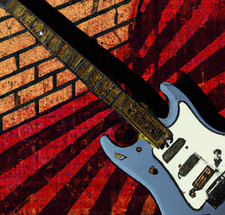Posted by Tony Romero on Sep 5th 2022
What is a Reverb effect?
When you think of reverb, you think of a tiled bathroon, a church, a concert hall, or maybe even a canyon. Wherever there are walls, a floor, or a ceiling, sound is going to bounce around and you are going to hear some type of reverb!
Reverb is a guitar effect that is commonly used to create a sense of space and depth in guitar playing. It is achieved by adding a delayed and decayed version of the original guitar signal to create an echo-like effect. This gives the impression that the guitar is being played in a larger space than it actually is, such as a concert hall or a cathedral.
The basic principle of guitar reverb is to create a reflective surface that bounces the sound waves of the guitar back towards the listener. This can be achieved using a range of different methods, including spring reverb tanks, digital reverb algorithms, and plate reverb units. Spring reverb tanks were commonly used in vintage guitar amplifiers, while digital reverb algorithms are more commonly used in modern pedals and processors.
Some reverb pedals give you options such as "Room", "Hall" and "Church" or "Lush". So what's the diff?
ROOM: A room typically has walls that are close to the source of the sound. So the sound bounces quickly off the walls and it decays quickly. Becuase of that, room reverbs are subtle, but very natural sounding. I typically start with a room reverb so that it isn't overbearing on my guitar sound. This is especially good for rythm guitars.
HALL: Concert halls are large rooms where sound can travel a long ways between walls. Because of this, the reverb can have long decays and the sound swells. Hall reverb can be a great effect for guitar solos where you have single notes that you want to sustain and provide a full sound.
LUSH or CHURCH/CATHEDRAL: When you think of caves, or cathedrals, you think of monks whose voices seem to belnd together in a lush oceon of sound and seems to carry on forever. Just like it sounds, you can get a very full reverb effect that seems to wash over your tone. It's very dreamy sounding with a long swelling reverb tail. Also great for surfer music. You may not want to use this effect all of the time, but can be very effective for certain types of guitar playing. However, long reverb effects can sound "mushy" if not done correctly! In the HandleBox ARTIE pedal, we added the infamous "Abbey Road EQ" setting here so that the lush effect sounds very musical- it eliminates the low-end boominess that can sound cluttered and overwhelming and also cuts out the high frequencies that can be screechy and annoying.
Many Reverb effects have a decay setting. Decay allows you to adjust the reverb length in seconds. This is an important knob to adjust to get the right amount of reverb for your song.
Many guitarists use reverb to add character and depth to their playing, and it can be heard in a wide range of musical styles from rock and blues to country and jazz. Some guitarists use reverb in a humorous way to create a surreal or otherworldly effect.
Here are a few examples:
Dick Dale - Known as the "King of Surf Guitar", Dick Dale used heavy reverb to create the distinctive sound of surf rock in the 1960s.
Jimi Hendrix - Jimi Hendrix was known for his innovative use of guitar effects, including reverb. In his song "Little Wing," he used reverb to create a dreamy, otherworldly atmosphere.
The Edge - The guitarist for U2, The Edge is famous for his use of digital delay also used reverb to create a spacious, ethereal sound.
Frank Zappa - Frank Zappa was known for his irreverent and often surreal approach to music, and he used reverb to create bizarre and unexpected soundscapes.
John Frusciante - Formerly of the Red Hot Chili Peppers, John Frusciante is known for his use of reverb to create a sense of depth and texture in his guitar playing.
Overall, guitar reverb is a versatile and powerful effect that can be used to add character and atmosphere to guitar playing. It has become an essential tool for many guitarists over the years.

